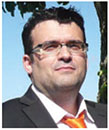Beyond the ocean: contamination of freshwater ecosystems with (micro-)plastic particles
Rachid Dris A , Hannes Imhof B , Wilfried Sanchez C , Johnny Gasperi A , François Galgani D , Bruno Tassin A E and Christian Laforsch B EA Université Paris Est, Laboratoire Eau Environnement Systèmes Urbains (LEESU), F-94010 Créteil, France.
B Department of Animal Ecology I and Bayreuth Center of Ecology and Environmental Research (BayCEER), University of Bayreuth, Universitätsstraße 30, D-95440 Bayreuth, Germany.
C Rovaltain Scientific Foundation for Environmental Toxicology and Ecotoxicology, 1 Rue Marc Seguin, Batiment INEED – Alixan, BP16110, F-26958 Valence Cedex 9, France.
D Institut Français pour la Recherche et l’Exploration de la Mer (IFREMER), Immeuble Agostini, ZI Furiani, F-20600, Bastia, Corsica, France.
E Corresponding authors. Email: bruno.tassin@enpc.fr; christian.laforsch@uni-bayreuth.de

Rachid Dris is a Ph.D. student at the University Paris-Est in the LEESU. He studied Environmental Sciences at University Paris-Est and obtained a Masters Degree in aquatic systems and water management. His Masters thesis was about a first analysis of microplastics in urban effluents in Paris (France). His thesis focuses on the sources and pathways of microplastic particles in an urban context and in receiving waters. |

Hannes Imhof studied biology at the Albert-Ludwigs University Freiburg, he moved to the Ludwig-Maximilian University Munich to finish his Diploma in ecology, zoology and cell biology. His Diploma thesis was about plasticity in morphology and behaviour of the coral-eating seastar Acanthaster planci. For his Ph.D. thesis, he started to work on the occurrence and effects of plastic particles in aquatic ecosystems with a focus on lakes and streams. This project is under the supervision of Professor Christian Laforsch, Animal Ecology I, at the University of Bayreuth. After a variety of methodological developments, his current work is about the occurrence of microplastic particles in lake and stream ecosystems, method standardisation and effects on organisms. |

Wilfried Sanchez has a Ph.D. in ecotoxicology from the National Museum of Natural History in Paris, France. After 10 years of research on the adverse effect of various emerging pollutants (pharmaceuticals, ionic liquids, microplastics) in fish, he is the executive director of the Rovaltain Scientific Foundation since September 2014. The Rovaltain Foundation aims to support research activities in environmental toxicology and ecotoxicology. |

Johnny Gasperi is a chemist and is working as Assistant Professor at LEESU. His first research activities deal with organic micropollutants in urban water and within the receiving water. He studied several pollutant classes such alkylphenols, phthalates, polybrominated diphenyl ethers (PBDEs), polycyclic aromatic hydrocarbons (PAHs), and pharmaceuticals in urban areas, from their emissions to their discharges into the aquatic environment. More recently, he decided to transfer this approach to microplastics and work on microplastic sources and fate in urban areas and their dynamics within the receiving water. |

François Galgani, Ph.D., project manager at IFREMER, has 25 years of research and monitoring in the fields of ecotoxicology, chemistry and marine litter. Dr Galgani also chairs the European Commission/DG ENV/ Marine Strategy Coordination Group/Technical group on marine litter and the United Nations Environmental Programme/Mediterranean pollution (MEDPOL) expert group on marine litter. |

Bruno Tassin is a senior scientist, Professor in Urban Hydrology at LEESU–École des Ponts ParisTech. After 15 years of research on the physical and biogeochemical modelling of lakes recovering from eutrophication, his research activities moved to the analysis of water quality in urban environments and its interactions with new water management approaches. In 2013, he started research on microplastics in urban environments at LEESU in collaboration with Johnny Gasperi. |

Christian Laforsch holds the Chair for Animal Ecology at the University of Bayreuth. His research group has great experience in aquatic ecology, especially on the effects of biotic and abiotic (multiple) stressors on limnetic biota. He was among the first authors to address the problem of microplastics in freshwater ecosystems |
Environmental Chemistry 12(5) 539-550 https://doi.org/10.1071/EN14172
Submitted: 31 August 2014 Accepted: 27 March 2015 Published: 6 August 2015
Environmental context. Microplastics in freshwater ecosystems are an increasingly important environmental issue, with the few available studies suggesting high contamination worldwide. Reliable data on concentrations, fluxes and polymer types in continental aquatic environments, including urban water systems, are needed. High environmental and ecological risk polymers and associated or adsorbed chemicals have to be identified, as well as their effects on both organisms and ecosystems.
Abstract. Massive accumulation of plastic particles has been reported for marine ecosystems around the world, posing a risk to the biota. Freshwater ecosystems have received less attention despite most plastic litter being produced onshore and introduced into marine environments by rivers. Some studies not only report the presence of microplastics in freshwater ecosystems, but show that contamination is as severe as in the oceans. In continental waters, microplastics have been observed in both sediments (predominantly lake shores but also riverbanks) and water samples (predominantly surface water of lakes and rivers). This review highlights recent findings and discusses open questions, focussing on the methodology of assessing this contaminant in freshwater ecosystems. In this context, method harmonisation is needed in order to obtain comparable data from different environmental compartments and sites. This includes sampling strategies (at spatial and temporal scales), sample treatment (taking into consideration high levels of organic matter and suspended solids) and reliable analytical methods to identify microplastics.
Additional keywords: emerging contaminants, freshwater ecosystems, lakes, plastic debris, plastic separation, polymer identification, rivers, sediment, urban water.
References
[1] Plastics – the Facts 2013, An Analysis of European Latest Plastics Production, Demand and Waste Data 2013, p. 40 (Plastics Europe, Association of Plastic Manufacturers: Brussels).[2] R. C. Thompson, Y. Olsen, R. P. Mitchell, A. Davis, S. J. Rowland, A. W. G. John, D. McGonigle, A. E. Russell, Lost at sea: where is all the plastic? Science 2004, 304, 838.
| Lost at sea: where is all the plastic?Crossref | GoogleScholarGoogle Scholar | 1:CAS:528:DC%2BD2cXjvVSntbg%3D&md5=155a0087d37591eee7bfac1da847674bCAS | 15131299PubMed |
[3] C. Arthur, J. Baker, H. Bamford, Summary of the international research workshop on the occurrence, effects, and fate of microplastic marine debris, in Proceedings of the International Research Workshop on the Occurrence, Effects and Fate of Microplastic Marine Debris, 9–11 September 2008, Tacoma, WA, USA (Eds C. Arthur, J. Baker, H. Bamford) 2009, NOAA Technical Memorandum NOS-OR&R-30, pp. 7–17 (National Oceanic and Atmospheric Administration: Washington, DC).
[4] V. Hidalgo-Ruz, L. Gutow, R. C. Thompson, M. Thiel, Microplastics in the marine environment: a review of the methods used for identification and quantification. Environ. Sci. Technol. 2012, 46, 3060.
| Microplastics in the marine environment: a review of the methods used for identification and quantification.Crossref | GoogleScholarGoogle Scholar | 1:CAS:528:DC%2BC38XitVGhurY%3D&md5=2acb9685cd991453468574d7dc04148eCAS | 22321064PubMed |
[5] M. Eriksen, L. C. M. Lebreton, H. S. Carson, M. Thiel, C. J. Moore, J. C. Borerro, F. Galgani, P. G. Ryan, J. Reisser, Plastic pollution in the world’s oceans: more than 5 trillion plastic pieces weighing over 250 000 tons afloat at sea. PLoS One 2014, 9, e111913.
| Plastic pollution in the world’s oceans: more than 5 trillion plastic pieces weighing over 250 000 tons afloat at sea.Crossref | GoogleScholarGoogle Scholar | 25494041PubMed |
[6] H. K. Imhof, J. Schmid, R. Niessner, N. P. Ivleva, C. Laforsch, A novel, highly efficient method for the separation and quantification of plastic particles in sediments of aquatic environments. Limnol. Oceanogr. Methods 2012, 10, 524.
| 1:CAS:528:DC%2BC38XhtlyntrfN&md5=b2457dab3b418e16f52c1327551bf523CAS |
[7] M. Eriksen, S. Mason, S. Wilson, C. Box, A. Zellers, W. Edwards, H. Farley, S. Amato, Microplastic pollution in the surface waters of the Laurentian Great Lakes. Mar. Pollut. Bull. 2013, 77, 177.
| Microplastic pollution in the surface waters of the Laurentian Great Lakes.Crossref | GoogleScholarGoogle Scholar | 1:CAS:528:DC%2BC3sXhs1yrtbrO&md5=e7ba2955d1cea1d616864efbc09ba802CAS | 24449922PubMed |
[8] M. Cole, P. Lindeque, C. Halsband, T. S. Galloway, Microplastics as contaminants in the marine environment: a review. Mar. Pollut. Bull. 2011, 62, 2588.
| Microplastics as contaminants in the marine environment: a review.Crossref | GoogleScholarGoogle Scholar | 1:CAS:528:DC%2BC3MXhsV2gsrfM&md5=fcc64c8a0c712ffd04c42c522f208e69CAS | 22001295PubMed |
[9] H. K. Imhof, N. P. Ivleva, J. Schmid, R. Niessner, C. Laforsch, Contamination of beach sediments of a subalpine lake with microplastic particles. Curr. Biol. 2013, 23, R867.
| Contamination of beach sediments of a subalpine lake with microplastic particles.Crossref | GoogleScholarGoogle Scholar | 1:CAS:528:DC%2BC3sXhsF2gtbfI&md5=6e11592ca247c7597cdffb6b3d2e79b6CAS | 24112978PubMed |
[10] M. Zbyszewski, P. Corcoran, Distribution and degradation of freshwater plastic particles along the beaches of Lake Huron, Canada. Water Air Soil Pollut. 2011, 220, 365.
| Distribution and degradation of freshwater plastic particles along the beaches of Lake Huron, Canada.Crossref | GoogleScholarGoogle Scholar | 1:CAS:528:DC%2BC3MXpvFCksbc%3D&md5=71b22e25862ad5d71914d1bb5551d1f7CAS |
[11] E. J. Carpenter, S. J. Anderson, G. R. Harvey, H. P. Miklas, B. B. Peck, Polystyrene spherules in coastal waters. Science 1972, 178, 749.
| Polystyrene spherules in coastal waters.Crossref | GoogleScholarGoogle Scholar | 1:CAS:528:DyaE3sXkslGjsQ%3D%3D&md5=c89e0dc0d37775628878a6476877a376CAS | 4628343PubMed |
[12] E. L. Venrick, T. W. Backman, W. C. Bartram, C. J. Platt, M. S. Thornhill, R. E. Yates, Man-made objects on the surface of the central North Pacific Ocean. Nature 1973, 241, 271.
| Man-made objects on the surface of the central North Pacific Ocean.Crossref | GoogleScholarGoogle Scholar |
[13] J. B. Colton, B. R. Burns, F. D. Knapp, Plastic particles in surface waters of the north-western Atlantic. Science 1974, 185, 491.
| Plastic particles in surface waters of the north-western Atlantic.Crossref | GoogleScholarGoogle Scholar | 17830390PubMed |
[14] C. S. Wong, D. R. Green, W. J. Cretney, Quantitative tar and plastic waste distributions in the Pacific Ocean. Nature 1974, 247, 30.
| Quantitative tar and plastic waste distributions in the Pacific Ocean.Crossref | GoogleScholarGoogle Scholar | 1:CAS:528:DyaE2cXhtFanurg%3D&md5=96af558e501a3b1cc296d97cb9ee55ebCAS |
[15] D. K. A. Barnes, F. Galgani, R. C. Thompson, M. Barlaz, Accumulation and fragmentation of plastic debris in global environments. Philos. Trans. R. Soc. Lond. B Biol. Sci. 2009, 364, 1985.
| Accumulation and fragmentation of plastic debris in global environments.Crossref | GoogleScholarGoogle Scholar | 1:CAS:528:DC%2BD1MXpt1Skt7w%3D&md5=c29927e7454ccee2ea68a6c4ffedea9bCAS |
[16] A. Vegter, M. Barletta, C. Beck, J. Borrero, H. Burton, M. Campbell, M. Costa, M. Eriksen, C. Eriksson, A. Estrades, K. Gilardi, B. Hardesty, J. I. d. Sul, J. Lavers, B. Lazar, L. Lebreton, W. Nichols, C. Ribic, P. Ryan, Q. Schuyler, S. Smith, H. Takada, K. Townsend, C. Wabnitz, C. Wilcox, L. Young, M. Hamann, Global research priorities to mitigate plastic pollution impacts on marine wildlife. Endanger. Species Res. 2014, 25, 225.
| Global research priorities to mitigate plastic pollution impacts on marine wildlife.Crossref | GoogleScholarGoogle Scholar |
[17] M. R. Gregory, Plastic ‘scrubbers’ in hand cleansers: a further (and minor) source for marine pollution identified. Mar. Pollut. Bull. 1996, 32, 867.
| Plastic ‘scrubbers’ in hand cleansers: a further (and minor) source for marine pollution identified.Crossref | GoogleScholarGoogle Scholar | 1:CAS:528:DyaK2sXnvVCqtA%3D%3D&md5=573a3ce45eefd96e38231502c2ef06a6CAS |
[18] M. A. Browne, P. Crump, S. J. Niven, E. Teuten, A. Tonkin, T. Galloway, R. Thompson, Accumulation of microplastic on shorelines worldwide: sources and sinks. Environ. Sci. Technol. 2011, 45, 9175.
| Accumulation of microplastic on shorelines worldwide: sources and sinks.Crossref | GoogleScholarGoogle Scholar | 1:CAS:528:DC%2BC3MXht1Gks7bN&md5=0004f85a816e01343ea841b1c13ca432CAS | 21894925PubMed |
[19] F. Dubaish, G. Liebezeit, Suspended microplastics and black carbon particles in the Jade System, southern North Sea. Water Air Soil Pollut. 2013, 224, 1352 .
| Suspended microplastics and black carbon particles in the Jade System, southern North Sea.Crossref | GoogleScholarGoogle Scholar |
[20] K. A. V. Zubris, B. K. Richards, Synthetic fibers as an indicator of land application of sludge. Environ. Pollut. 2005, 138, 201.
| Synthetic fibers as an indicator of land application of sludge.Crossref | GoogleScholarGoogle Scholar | 1:CAS:528:DC%2BD2MXmvVCgsbs%3D&md5=4a01d6706df2928766b9338bb6cc4dc8CAS |
[21] M. C. Rillig, Microplastic in terrestrial ecosystems and the soil? Environ. Sci. Technol. 2012, 46, 6453.
| Microplastic in terrestrial ecosystems and the soil?Crossref | GoogleScholarGoogle Scholar | 1:CAS:528:DC%2BC38XnslGqsrY%3D&md5=d8bcbe21f0dfcbeb3ca4dc2891c6d5f1CAS | 22676039PubMed |
[22] R. Dris, J. Gasperi, V. Rocher, M. Saad, N. Renault, B. Tassin, Microplastic contamination in an urban area: a case study in Greater Paris. Environ. Chem. 2015,
[23] European Union. Directive 2008/56/EC of the European Parliament and of the Council of 17 June 2008 Establishing a Framework for Community Action in the Field of Marine Environmental Policy 2008 (Marine Strategy Framework Directive). Available at http://eur-lex.europa.eu [Verified 30 August 2014].
[24] European Union, Directive 2000/60/EC of the European Parliament and of the Council of 23 October 2000 establishing a Framework for Community Action in the Field of Water Policy 2000. Available at http://eur-lex.europa.eu [Verified 30 August 2014].
[25] M. A. Browne, T. S. Galloway, R. C. Thompson, Spatial patterns of plastic debris along estuarine shorelines. Environ. Sci. Technol. 2010, 44, 3404.
| Spatial patterns of plastic debris along estuarine shorelines.Crossref | GoogleScholarGoogle Scholar | 1:CAS:528:DC%2BC3cXktlyjtb4%3D&md5=6c6adb982561be02195c26f040eba178CAS | 20377170PubMed |
[26] S. S. Sadri, R. C. Thompson, On the quantity and composition of floating plastic debris entering and leaving the Tamar Estuary, south-west England. Mar. Pollut. Bull. 2014, 81, 55.
| On the quantity and composition of floating plastic debris entering and leaving the Tamar Estuary, south-west England.Crossref | GoogleScholarGoogle Scholar | 1:CAS:528:DC%2BC2cXjvFWiu7c%3D&md5=14a858d6bd2c72ad84cf8cfd17d81dd1CAS | 24613232PubMed |
[27] S. Zhao, L. Zhu, T. Wang, D. Li, Suspended microplastics in the surface water of the Yangtze Estuary System, China: first observations on occurrence, distribution. Mar. Pollut. Bull. 2014, 86, 562.
| Suspended microplastics in the surface water of the Yangtze Estuary System, China: first observations on occurrence, distribution.Crossref | GoogleScholarGoogle Scholar | 1:CAS:528:DC%2BC2cXhtFCmtLbI&md5=a33f4971ecfd16fd3be0707d14166f85CAS | 25023438PubMed |
[28] F. Faure, M. Corbaz, H. Baecher, L. de Alencastro, Pollution due to plastics and microplastics in Lake Geneva and in the Mediterranean Sea. Arch. Sci. 2012, 65, 157.
| 1:CAS:528:DC%2BC3sXhsVWjsrzP&md5=4af1b656e55fa2982694c00c59b802d4CAS |
[29] F. Faure, V. Gagnaux, H. Baecher, V. Neuhaus, L. de Alencastro, Microplastiques sur les plages et la surface du Léman. Résultats préliminaires. Bulletin de l’ARPEA 2013, 49, 15.
[30] M. Zbyszewski, P. L. Corcoran, A. Hockin, Comparison of the distribution and degradation of plastic debris along shorelines of the Great Lakes, North America. J. Great Lakes Res. 2014, 40, 288.
| Comparison of the distribution and degradation of plastic debris along shorelines of the Great Lakes, North America.Crossref | GoogleScholarGoogle Scholar | 1:CAS:528:DC%2BC2cXksFyrtbw%3D&md5=a54ce6c5bf92892ecfa3f1541805e3faCAS |
[31] J. G. B. Derraik, The pollution of the marine environment by plastic debris: a review. Mar. Pollut. Bull. 2002, 44, 842.
| The pollution of the marine environment by plastic debris: a review.Crossref | GoogleScholarGoogle Scholar | 1:CAS:528:DC%2BD38XmvVWns78%3D&md5=757914de79ed2efe1b2b0e3debf4df61CAS |
[32] R. A. Castañeda, S. Avlijas, M. A. Simard, A. Ricciardi, Microplastic pollution in St Lawrence River sediments. Can. J. Fish. Aquat. Sci. 2014, 71, 1767.
| Microplastic pollution in St Lawrence River sediments.Crossref | GoogleScholarGoogle Scholar |
[33] S. Rech, V. Macaya-Caquilpán, J. F. Pantoja, M. M. Rivadeneira, D. Jofre Madariaga, M. Thiel, Rivers as a source of marine litter – a study from the SE Pacific. Mar. Pollut. Bull. 2014, 82, 66.
| Rivers as a source of marine litter – a study from the SE Pacific.Crossref | GoogleScholarGoogle Scholar | 1:CAS:528:DC%2BC2cXlvFeksbs%3D&md5=a18b68588cd70c2c3daad312f2183504CAS | 24726186PubMed |
[34] H. K. Imhof, N. P. Ivleva, J. Schmid, R. Niessner, C. Laforsch, Contamination of beach sediments of a subalpine lake with microplastic particles. Curr. Biol. 2013, 23, R867.
| Contamination of beach sediments of a subalpine lake with microplastic particles.Crossref | GoogleScholarGoogle Scholar | 1:CAS:528:DC%2BC3sXhsF2gtbfI&md5=6e11592ca247c7597cdffb6b3d2e79b6CAS | 24112978PubMed |
[35] C. M. Free, O. P. Jensen, S. A. Mason, M. Eriksen, N. J. Williamson, B. Boldgiv, High-levels of microplastic pollution in a large, remote, mountain lake. Mar. Pollut. Bull. 2014, 85, 156.
| High-levels of microplastic pollution in a large, remote, mountain lake.Crossref | GoogleScholarGoogle Scholar | 1:CAS:528:DC%2BC2cXhtlarurbJ&md5=3e7a706e1c1c4479f8eef370965c083bCAS | 24973278PubMed |
[36] C. Sofra, B. Calarke, G. D. Calarke, Microplastics in the Marine Environment: Investigating Possible Sources, Presence and Abundance. Poster presented at Student Research Meeting, 21 September 2010, London 2010. Available at https://workspace.imperial.ac.uk/ewre/Public/MSc%20posters%202010/Sofra%20FOWLER.pdf [Verified 23 May 2015].
[37] C. J. Moore, G. L. Lattin, A. F. Zellers, Quantity and type of plastic debris flowing from two urban rivers to coastal waters and beaches of southern. J. Integr. Coastal Zone Manag. 2011, 11, 65.
[38] A. Lechner, H. Keckeis, F. Lumesberger-Loisl, B. Zens, R. Krusch, M. Tritthart, M. Glas, E. Schludermann, The Danube so colourful: a potpourri of plastic litter outnumbers fish larvae in Europe’s second largest river. Environ. Pollut. 2014, 188, 177.
| The Danube so colourful: a potpourri of plastic litter outnumbers fish larvae in Europe’s second largest river.Crossref | GoogleScholarGoogle Scholar | 1:CAS:528:DC%2BC2cXjsFyqtbw%3D&md5=72efea79de3dd8cf45617ee3e236550dCAS | 24602762PubMed |
[39] A. McCormick, T. J. Hoellein, S. A. Mason, J. Schluep, J. J. Kelly, Microplastic is an abundant and distinct microbial habitat in an urban river. Environ. Sci. Technol. 2014, 48, 11863.
| Microplastic is an abundant and distinct microbial habitat in an urban river.Crossref | GoogleScholarGoogle Scholar | 1:CAS:528:DC%2BC2cXhsFGlsrjL&md5=ee63405e95eefec83cf1456e8717c442CAS | 25230146PubMed |
[40] L. T. Yonkos, E. A. Friedel, A. C. Perez-Reyes, S. Ghosal, C. D. Arthur, Microplastics in four estuarine rivers in the Chesapeake Bay, USA. Environ. Sci. Technol. 2014, 48, 14195.
| Microplastics in four estuarine rivers in the Chesapeake Bay, USA.Crossref | GoogleScholarGoogle Scholar | 1:CAS:528:DC%2BC2cXhvFSqurbN&md5=730d928dbe3976a945012f0ee3bd8fb2CAS | 25389665PubMed |
[41] D. Morritt, P. V. Stefanoudis, D. Pearce, O. A. Crimmen, P. F. Clark, Plastic in the Thames: a river runs through it. Mar. Pollut. Bull. 2014, 78, 196.
| Plastic in the Thames: a river runs through it.Crossref | GoogleScholarGoogle Scholar | 1:CAS:528:DC%2BC3sXhslOls7jO&md5=4561f1723610eca58a95d4461ce488f7CAS | 24239306PubMed |
[42] J. Gasperi, R. Dris, T. Bonin, V. Rocher, B. Tassin, Assessment of floating plastic debris in surface water along the Seine River. Environ. Pollut. 2014, 195, 163.
| Assessment of floating plastic debris in surface water along the Seine River.Crossref | GoogleScholarGoogle Scholar | 1:CAS:528:DC%2BC2cXhsFCitrfL&md5=3ff3b7dfc390b99d6841ded3ec54891fCAS | 25240189PubMed |
[43] W. Sanchez, C. Bender, J.-M. Porcher, Wild gudgeons (Gobio gobio) from French rivers are contaminated by microplastics: preliminary study and first evidence. Environ. Res. 2014, 128, 98.
| Wild gudgeons (Gobio gobio) from French rivers are contaminated by microplastics: preliminary study and first evidence.Crossref | GoogleScholarGoogle Scholar | 1:CAS:528:DC%2BC3sXhvV2gt7%2FE&md5=e3349563a15b5b3367bbe9eca0d52636CAS | 24295902PubMed |
[44] M. Eriksen, N. Maximenko, M. Thiel, A. Cummins, G. Lattin, S. Wilson, J. Hafner, A. Zellers, S. Rifman, Plastic pollution in the South Pacific subtropical gyre. Mar. Pollut. Bull. 2013, 68, 71.
| Plastic pollution in the South Pacific subtropical gyre.Crossref | GoogleScholarGoogle Scholar | 1:CAS:528:DC%2BC3sXntFygug%3D%3D&md5=423c3d25c581034719e4f9809f916001CAS | 23324543PubMed |
[45] F. Galgani, D. Fleet, J. Van Franeker, S. Katsanevakis, T. Maes, J. Mouat, L. Oosterbaan, I. Poitou, G. Hanke, R. C. Thompson, E. Amato, A. Birkun, C. Janssen, JRC Scientific and Policy Reports, Report EUR 26113 EN, A Guidance Document Within the Common Implementation, Strategy for the Marine Strategy Framework Directive 2013 (Publications Office of the European Union: Luxembourg). Available at https://ec.europa.eu/jrc/sites/default/files/lb-na-26113-en-n.pdf [Verified 23 May 2015].
[46] S. L. Wright, R. C. Thompson, T. S. Galloway, The physical impacts of microplastics on marine organisms: a review. Environ. Pollut. 2013, 178, 483.
| The physical impacts of microplastics on marine organisms: a review.Crossref | GoogleScholarGoogle Scholar | 1:CAS:528:DC%2BC3sXltVCrtLc%3D&md5=e8d21e474857816bde6b082a00007f7bCAS | 23545014PubMed |
[47] M. Claessens, L. Van Cauwenberghe, M. B. Vandegehuchte, C. R. Janssen, New techniques for the detection of microplastics in sediments and field-collected organisms. Mar. Pollut. Bull. 2013, 70, 227.
| New techniques for the detection of microplastics in sediments and field-collected organisms.Crossref | GoogleScholarGoogle Scholar | 1:CAS:528:DC%2BC3sXmtVagtbs%3D&md5=b4f4051dbc086997db32828088f58c11CAS | 23601693PubMed |
[48] M.-T. Nuelle, J. H. Dekiff, D. Remy, E. Fries, A new analytical approach for monitoring microplastics in marine sediments. Environ. Pollut. 2014, 184, 161.
| A new analytical approach for monitoring microplastics in marine sediments.Crossref | GoogleScholarGoogle Scholar | 1:CAS:528:DC%2BC3sXhvVWlt7%2FL&md5=6c46200a245f87066cf6d3f148a5a9beCAS | 24051349PubMed |
[49] H. T. Shent, R. J. Pugh, E. Forssberg, A review of plastics waste recycling and the flotation of plastics. Resour. Conserv. Recycling 1999, 25, 85.
| A review of plastics waste recycling and the flotation of plastics.Crossref | GoogleScholarGoogle Scholar |
[50] A. Mathalon, P. Hill, Microplastic fibers in the intertidal ecosystem surrounding Halifax Harbor, Nova Scotia. Mar. Pollut. Bull. 2014, 81, 69.
| Microplastic fibers in the intertidal ecosystem surrounding Halifax Harbor, Nova Scotia.Crossref | GoogleScholarGoogle Scholar | 1:CAS:528:DC%2BC2cXks1Wrsr0%3D&md5=13bc61b2e7068812a2e9ee092018493fCAS | 24650540PubMed |
[51] L. Van Cauwenberghe, C. R. Janssen, Microplastics in bivalves cultured for human consumption. Environ. Pollut. 2014, 193, 65.
| Microplastics in bivalves cultured for human consumption.Crossref | GoogleScholarGoogle Scholar | 1:CAS:528:DC%2BC2cXht1ensbjF&md5=ae637f79e745613d267b65e924ff1e21CAS | 25005888PubMed |
[52] G. W. Ehrenstein, S. Pongratz, Beständigkeit von Kunststoffen 2007 (Hanser: München).
[53] M. Cole, H. Webb, P. K. Lindeque, E. S. Fileman, C. Halsband, T. S. Galloway, Isolation of microplastics in biota-rich seawater samples and marine organisms. Sci. Rep. 2014, 4, 4528.
| Isolation of microplastics in biota-rich seawater samples and marine organisms.Crossref | GoogleScholarGoogle Scholar | 24681661PubMed |
[54] T. Rocha-Santos, A. C. Duarte, A critical overview of the analytical approaches to the occurrence, the fate and the behavior of microplastics in the environment. TrAC Trends in Analytical Chemistry 2015, 65, 47.
| A critical overview of the analytical approaches to the occurrence, the fate and the behavior of microplastics in the environment.Crossref | GoogleScholarGoogle Scholar | 1:CAS:528:DC%2BC2MXht1Oqu7g%3D&md5=a26311c079bc44c9ca9d7b9688063aefCAS |
[55] E. Fries, J. H. Dekiff, J. Willmeyer, M.-T. Nuelle, M. Ebert, D. Remy, Identification of polymer types and additives in marine microplastic particles using pyrolysis-GC/MS and scanning electron microscopy. Environ. Sci. Process. Impacts 2013, 15, 1949.
| Identification of polymer types and additives in marine microplastic particles using pyrolysis-GC/MS and scanning electron microscopy.Crossref | GoogleScholarGoogle Scholar | 1:CAS:528:DC%2BC3sXhsFWlurnP&md5=097be75fc57068f7942244d968d9a57eCAS | 24056666PubMed |
[56] G. Volkheimer, Hematogenous dissemination of ingested polyvinyl chloride particles. Ann. N. Y. Acad. Sci. 1975, 246, 164.
| Hematogenous dissemination of ingested polyvinyl chloride particles.Crossref | GoogleScholarGoogle Scholar | 1:STN:280:DyaE2M7ksVyrsA%3D%3D&md5=62fa1b18ae15c8830edda5b4214737b3CAS | 1054950PubMed |
[57] N. Hussain, V. Jaitley, A. T. Florence, Recent advances in the understanding of uptake of microparticulates across the gastrointestinal lymphatics. Adv. Drug Deliv. Rev. 2001, 50, 107.
| Recent advances in the understanding of uptake of microparticulates across the gastrointestinal lymphatics.Crossref | GoogleScholarGoogle Scholar | 1:CAS:528:DC%2BD3MXlsF2js7Y%3D&md5=19b50c73ee44d8a21e18f54790cb3260CAS | 11489336PubMed |
[58] K. E. Carr, S. H. Smyth, M. T. McCullough, J. F. Morris, S. M. Moyes, Morphological aspects of interactions between microparticles and mammalian cells: intestinal uptake and onward movement. Prog. Histochem. Cytochem. 2012, 46, 185.
| Morphological aspects of interactions between microparticles and mammalian cells: intestinal uptake and onward movement.Crossref | GoogleScholarGoogle Scholar | 22240063PubMed |
[59] M. A. Browne, A. Dissanayake, T. S. Galloway, D. M. Lowe, R. C. Thompson, Ingested microscopic plastic translocates to the circulatory system of the mussel, Mytilus edulis (L.). Environ. Sci. Technol. 2008, 42, 5026.
| Ingested microscopic plastic translocates to the circulatory system of the mussel, Mytilus edulis (L.).Crossref | GoogleScholarGoogle Scholar | 1:CAS:528:DC%2BD1cXmsVKhtb8%3D&md5=b4626ca3c3e4bda09b7035ddf2d396e4CAS | 18678044PubMed |
[60] Y. Ogata, H. Takada, K. Mizukawa, H. Hirai, S. Iwasa, S. Endo, Y. Mato, M. Saha, K. Okuda, A. Nakashima, M. Murakami, N. Zurcher, R. Booyatumanondo, M. P. Zakaria, L. Q. Dung, M. Gordon, C. Miguez, S. Suzuki, C. Moore, H. K. Karapanagioti, S. Weerts, T. McClurg, E. Burres, W. Smith, M. V. Velkenburg, J. S. Lang, R. C. Lang, D. Laursen, B. Danner, N. Stewardson, R. C. Thompson, International pellet watch: global monitoring of persistent organic pollutants (POPs) in coastal waters. 1. Initial phase data on PCBs, DDTs, and HCHs. Mar. Pollut. Bull. 2009, 58, 1437.
| International pellet watch: global monitoring of persistent organic pollutants (POPs) in coastal waters. 1. Initial phase data on PCBs, DDTs, and HCHs.Crossref | GoogleScholarGoogle Scholar | 1:CAS:528:DC%2BD1MXhtFygs7zK&md5=7b92670f2441ead79b7c9cdd199c924aCAS | 19635625PubMed |


